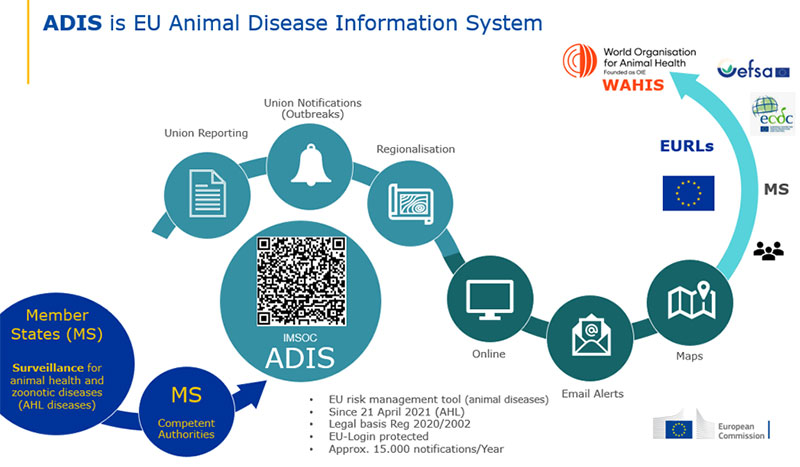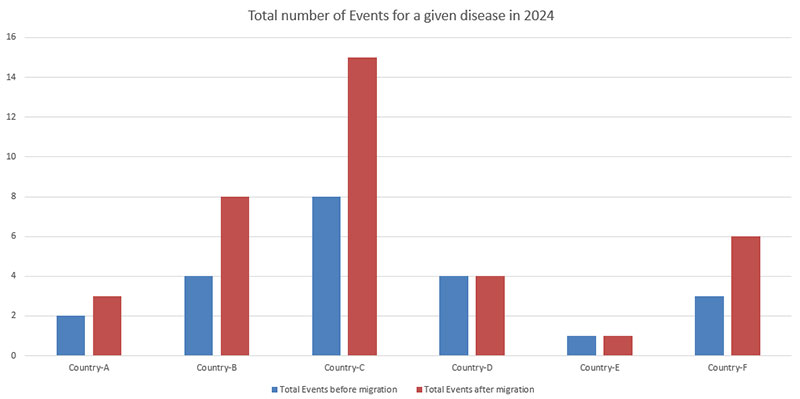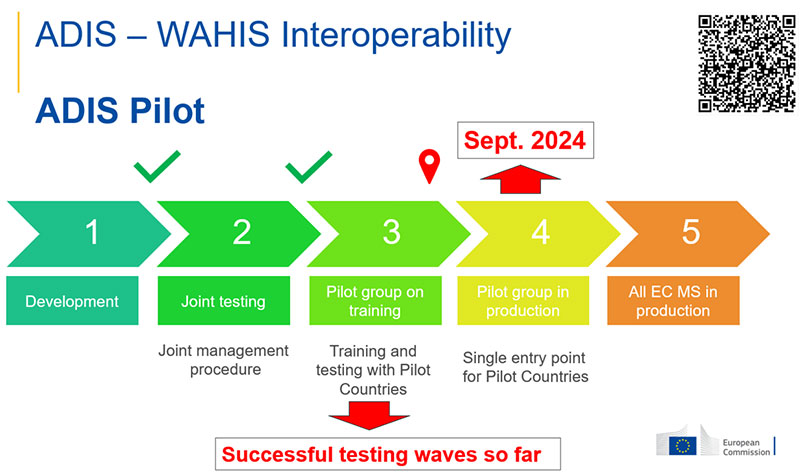Modernising Animal Health Data Management
The Animal Disease Information System (ADIS) is an innovative digital platform developed by the European Union (EU) to streamline animal health data collection and analysis. By integrating both Union Notification and Union Reporting, ADIS aims to significantly improve decision-making processes and disease control measures in the EU. This novel platform works in tandem with the World Animal Health Information System (WAHIS), managed by the World Organisation for Animal Health (WOAH), founded as OIE. This page will explain the ADIS connection with WAHIS, highlighting the benefits of their collaboration and providing examples of their practical applications.
What is ADIS?
ADIS is a secure digital platform designed by the European Commission to provide a centralised hub for animal health data management in the EU. The system is built to simplify data notification and reporting, improve data quality and accuracy, and facilitate data entry by the Competent Authorities. By enabling efficient, one-time reporting for EU Member States and associated countries, ADIS reduces the administrative burden and ensures data consistency. ADIS empowers decision-makers to make well-informed choices based on the most current and accurate information available.
For example, during an outbreak of an animal disease (e.g. African swine fever) in a Member State, ADIS would allow for timely notification of the outbreak both in ADIS and in WAHIS at the same time; thus fostering global rapid response to contain the spread of the disease while optimising workload for national Competent Authorities.

Figure 1: ADIS Overview
The Connection Between ADIS and WAHIS
The interoperability between ADIS and WAHIS is a critical aspect of their collaboration. These two systems exchange data through Application Programming Interfaces (APIs), ensuring a seamless flow of information between them. This data exchange is designed to allow for efficient notification of exceptional events in WAHIS while maintaining a single reporting process for EU Member States. Note that Six-monthly and Annual reports will still need to be submitted to WAHIS. The scope of current interconnection applies to Early Warning notifications only (immediate notifications and follow-up reports).
An example of this interoperability is the dispatch of event and outbreak data from ADIS to WAHIS, the ‘pulling’ of reference tables from WAHIS or the feedback loop related to the WOAH validation process to be fed into ADIS.
To enhance the management of this data-sharing platform, a Joint Management Procedure (JMP) document has been signed to ensure the swift processing of requests. This JMP will address various scenarios beyond day-to-day business requirements, anticipating borderline cases, detailing how to handle them, and minimising downtime and data discrepancies.
The Benefits of ADIS-WAHIS Collaboration
The collaboration between ADIS and WAHIS exemplifies how digital platforms can work together to improve animal health data management on a global scale. The interconnection of these systems offers several advantages:
- Enhanced data quality and consistency: By exchanging data between ADIS and WAHIS, both systems can maintain accurate and up-to-date information, improving the overall quality of animal health data. This is particularly important in the case of risk assessments which need reliable data sources.
- Streamlined notification by Member States: The interoperability of ADIS and WAHIS allows for efficient, one-time data entry for EU Member States, reducing the administrative burden and ensuring data consistency. For instance, in a foot and mouth disease (FMD) outbreak, Member States can quickly input data into ADIS, which is then automatically shared with WAHIS, ensuring information sharing which fulfils requirements of both EU legislation and WOAH international standards.
- Improved decision-making: With access to comprehensive and current animal health data, decision-makers can make better-informed choices regarding disease surveillance and control measures. A new section of the ADIS public interface is being developed to make the most important information available to the public.
The migration process for linking ADIS with WAHIS
Migration process has been planned in a careful manner considering potential pitfalls and resources available for the connection of both systems. Some major issues need to be considered, e.g. how to handle ongoing events and outbreaks ongoing in WAHIS at the time of the ADIS-WAHIS linking.
“How migration is being handled”: a complete data transfer of all outbreaks from WAHIS to ADIS would not be practical. ADIS users would need to perform a significantly time-consuming verification of the migrated data. Migration of the ongoing events alone from WAHIS is also not considered as a good solution as it would only provide a partial view of newly created outbreaks within ADIS.
Therefore, the chosen solution, backed by the Member States, will be to close the ongoing events in WAHIS prior to interconnection. If required, ongoing events will be re-open in ADIS with ongoing and new outbreaks. This reduces the previously described issues and simplifies the migration process.
Impact of the migration on data displayed in WAHIS:
- The total number of outbreaks should not be affected by the migration, in normal conditions.
For the majority of outbreaks, they will be closed by the reporting country in WAHIS for ongoing events shortly before the migration. However, for those outbreaks that do not meet the requirements to be closed in WAHIS on the migration date, these would need to be re-opened in ADIS and this could result in an apparent increase in the outbreak count. - Risk related to the misreading of events totals as ongoing events closed before the migration might be re-created in ADIS (if the epidemiological situation so requires). This will result in some cases in a higher total number of events. This increase, although is not a real increase of events, can be the result of the migration. This could have an impact on the total number of events recorded in the six-monthly reports.

Figure 2: Event chart (fictive data): In the example chart you can see that some countries needed to re-open the events after the migration as there are still ongoing outbreaks.
Therefore, it is recommended that special attention is required when comparing data before and after the migration to avoid misunderstanding of the reason of the possible increase in the number of events and outbreaks in WAHIS. For some countries there might be no increase of events if it was decided, on epidemiological grounds, that the event was fully resolved.
As a mitigating measure, the re-opening in ADIS of an event just closed in WAHIS would not trigger the WAHIS Immediate Notification alert email as this would be part of the transition process. Re-opened events will be identified by the existence of an epidemiological comment referencing the previously closed event; such comments will be entered both in the WAHIS event to be closed and in the newly created event in ADIS. Events closed with the stable epidemiological situation in WAHIS would require continued reporting in the Six-monthly reports as per normal WOAH requirements.
WAHIS follows a data validation process that might exceptionally result in data differences with ADIS during the synchronisation process and/or when additional clarifications or justifications are requested by WOAH.
This migration requires the collaboration of multiple actors and as a strict migration period is not possible to provide, everything will be put in place to reduce the impact. This migration will require a number of activities and a detailed transition plan is being developed. Before the migration, a dedicated ‘hands-on’ workshop for ADIS users will be organised.
Timeline
Linking ADIS and WAHIS has now entered in the third step of the Pilot Phase. While the Pilot Member States are already using a test environment where ADIS and WAHIS are actively linked, the move to the next step (Pilot Phase 4) for the Pilot Member States is planned for September 2024, with a gradual progression to all Member States before the end of the year.

Figure 3: ADIS-WAHIS interoperability timeline.
Conclusions
The implementation of ADIS and its connection with WAHIS represent significant advancements in animal health data management. By working together, these platforms deliver substantial benefits for EU Member States, associated countries, and global stakeholders.
However the transition phase needs to be understood by all WAHIS and ADIS users in order to be able to interpret the data in the right context and draw the correct conclusions as the migration process might trigger increases in the number of recorded events for all ADIS users.
Further information
- ADIS EU Legal basis: The EU Legal basis is based on the modern framework provided by Regulation (EU) 2016/429 ('Animal Health Law') and on the Commission Implementing Regulation (EU) 2020/2002 laying down rules regard to Union notification and Union reporting.
- For exceptional events, ADIS will fulfil the WOAH notification requirements as set in its International Standards:
- Contact email: SANTE-ADIS-SUPPORT@ec.europa.eu
